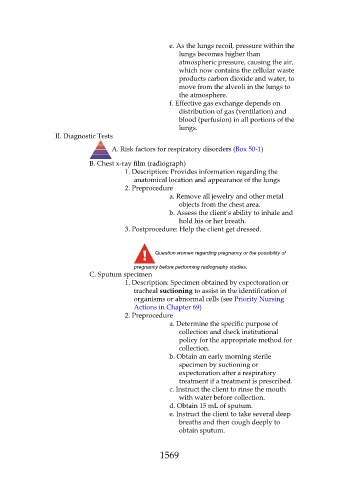Page 1569 - Saunders Comprehensive Review For NCLEX-RN
P. 1569
e. As the lungs recoil, pressure within the
lungs becomes higher than
atmospheric pressure, causing the air,
which now contains the cellular waste
products carbon dioxide and water, to
move from the alveoli in the lungs to
the atmosphere.
f. Effective gas exchange depends on
distribution of gas (ventilation) and
blood (perfusion) in all portions of the
lungs.
II. Diagnostic Tests
A. Risk factors for respiratory disorders (Box 50-1)
B. Chest x-ray film (radiograph)
1. Description: Provides information regarding the
anatomical location and appearance of the lungs
2. Preprocedure
a. Remove all jewelry and other metal
objects from the chest area.
b. Assess the client’s ability to inhale and
hold his or her breath.
3. Postprocedure: Help the client get dressed.
Question women regarding pregnancy or the possibility of
pregnancy before performing radiography studies.
C. Sputum specimen
1. Description: Specimen obtained by expectoration or
tracheal suctioning to assist in the identification of
organisms or abnormal cells (see Priority Nursing
Actions in Chapter 69)
2. Preprocedure
a. Determine the specific purpose of
collection and check institutional
policy for the appropriate method for
collection.
b. Obtain an early morning sterile
specimen by suctioning or
expectoration after a respiratory
treatment if a treatment is prescribed.
c. Instruct the client to rinse the mouth
with water before collection.
d. Obtain 15 mL of sputum.
e. Instruct the client to take several deep
breaths and then cough deeply to
obtain sputum.
1569

